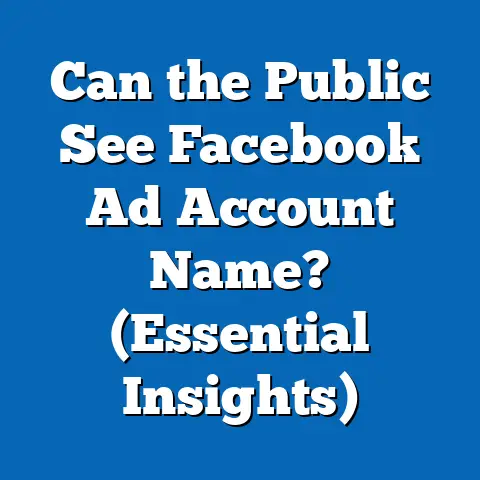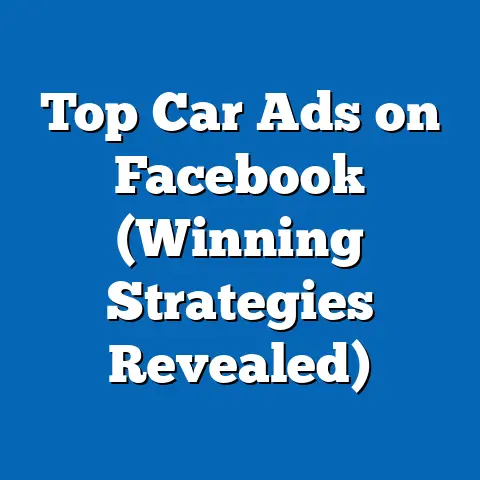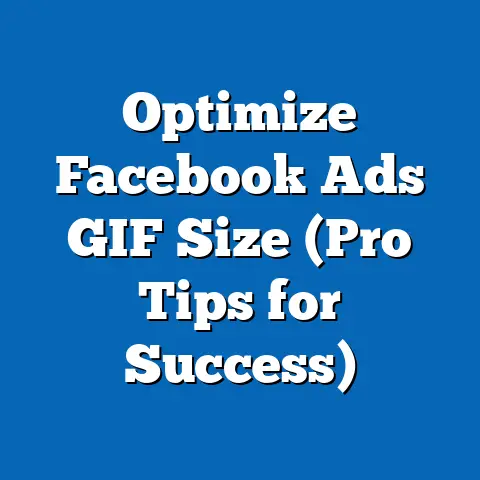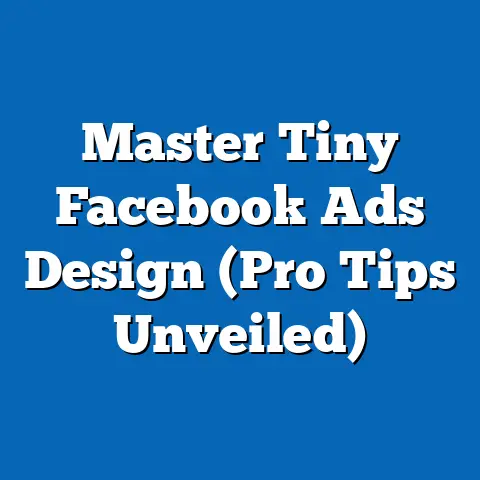Master Facebook Ad Charges (Unlock Hidden Cost-Saving Secrets)
Mastering the intricacies of Facebook advertising charges is a critical skill for businesses, marketers, and entrepreneurs aiming to maximize their return on investment (ROI). With over 2.9 billion monthly active users as of 2023, Facebook (now part of Meta) remains one of the most powerful platforms for reaching targeted audiences. However, the complexity of its ad pricing structure often leaves advertisers struggling to optimize costs while achieving desired outcomes.
Section 1: Understanding the Resale Value of Facebook Advertising
The concept of “resale value” in the context of Facebook advertising refers to the enduring benefits and potential returns a business can derive from its ad spend over time. Unlike traditional advertising, where exposure might be fleeting, a well-crafted Facebook ad campaign can generate long-term value through sustained engagement, brand loyalty, and customer acquisition. This resale value hinges on factors such as audience targeting precision, content relevance, and the ability to repurpose data from campaigns for future marketing efforts.
Facebook’s ad platform offers unparalleled opportunities for businesses to build relationships with customers, thanks to its robust data collection and targeting capabilities. For instance, a single ad campaign can yield insights into customer behavior, preferences, and demographics, which can be leveraged for future campaigns or even sold as anonymized data insights to third parties in some cases. This creates a cyclical value proposition—initial ad spend translates into data, which then informs more efficient spending down the line.
Historically, the resale value of digital advertising on platforms like Facebook emerged as a game-changer in the early 2000s when social media began transforming marketing paradigms. Launched in 2004, Facebook introduced its advertising platform in 2007, initially as a rudimentary system for small businesses and student groups. Over time, with the introduction of features like Custom Audiences (2012) and Lookalike Audiences (2013), advertisers gained tools to maximize the long-term value of their investments by reaching highly specific segments of the population.
The societal implications of this resale value are profound. On one hand, it democratizes advertising by allowing small businesses with limited budgets to compete with larger corporations through precise targeting and data-driven strategies. On the other hand, it raises ethical concerns about data privacy and the commodification of personal information, as the resale value often depends on extensive user tracking. These tensions continue to shape public discourse and regulatory frameworks, such as the European Union’s General Data Protection Regulation (GDPR) implemented in 2018, which seeks to balance innovation with consumer rights.
Section 2: Key Defining Characteristics of Facebook Ad Charges
To fully grasp the cost dynamics of Facebook advertising, it’s essential to understand the platform’s pricing structure and the factors that influence charges. Unlike a fixed-rate model, Facebook operates on an auction-based system where advertisers bid for ad placements based on their objectives, target audience, and competition. This system, while flexible, can be daunting for newcomers due to its variability and lack of transparency in real-time costs.
One defining characteristic is the use of Cost Per Mille (CPM), Cost Per Click (CPC), and Cost Per Action (CPA) metrics to determine charges. CPM refers to the cost per 1,000 impressions, ideal for brand awareness campaigns, while CPC charges advertisers only when users click on their ads, suitable for driving traffic. CPA, on the other hand, focuses on specific actions like purchases or sign-ups, aligning costs directly with conversions.
Another key characteristic is the role of relevance and quality scores in determining ad costs. Facebook assigns each ad a relevance score based on user engagement and feedback, which influences how often the ad is shown and at what cost. High-quality, engaging ads typically result in lower charges per impression or click, creating an incentive for advertisers to prioritize user experience over sheer volume.
Additionally, audience targeting parameters significantly impact costs. Narrowly defined audiences—such as those based on specific interests, behaviors, or demographics—often come with higher costs due to increased competition for limited inventory. Conversely, broader audiences may reduce costs but dilute campaign effectiveness, highlighting the need for a strategic balance.
Section 3: Historical Context of Facebook Advertising Costs
The evolution of Facebook’s advertising model provides critical context for understanding current cost structures and their societal impact. When Facebook Ads launched in 2007, the platform offered a simple, low-cost way for businesses to reach users through sidebar ads and sponsored posts. Early advertisers paid minimal fees, often as low as $0.01 per click, reflecting the platform’s nascent stage and limited competition.
By 2012, as Facebook’s user base surpassed 1 billion, the platform introduced more sophisticated tools like the Ads Manager and Power Editor, enabling advertisers to create highly targeted campaigns. This shift coincided with a sharp increase in ad costs, driven by growing demand and the introduction of mobile advertising, which accounted for 41% of ad revenue by 2013. The rise of mobile-first users forced advertisers to adapt, often at a premium, as mobile ad slots became more competitive.
The mid-2010s marked another turning point with the rollout of algorithmic bidding and machine learning-driven ad placements. These innovations allowed Facebook to optimize ad delivery for maximum ROI, but they also obscured cost transparency, as advertisers could no longer predict charges with certainty. According to a 2019 study by WordStream, average CPC on Facebook rose by 17% year-over-year, reflecting both increased competition and the platform’s push toward value-based pricing.
Societally, these cost escalations have had mixed effects. While they’ve made advertising more accessible to data-savvy businesses, they’ve also marginalized smaller players unable to afford competitive bids. Moreover, the Cambridge Analytica scandal of 2018 exposed how ad targeting could be exploited for political manipulation, prompting public backlash and stricter regulations that indirectly influenced ad costs through reduced data availability.
Section 4: Societal Implications of Facebook Ad Charges
The cost structure of Facebook advertising extends beyond mere economics, shaping societal norms, business practices, and cultural dynamics. One major implication is the democratization of marketing reach, as businesses of all sizes can access global audiences for relatively low entry costs compared to traditional media like television or print. A 2022 report by Hootsuite found that 93% of social media marketers use Facebook Ads, underscoring its role as a leveling tool in the digital economy.
However, this democratization comes with disparities. High ad costs in competitive industries—such as e-commerce, where average CPC can exceed $1.50—often exclude small businesses or startups with limited budgets. This creates a digital divide, where only well-funded entities can sustain long-term campaigns, reinforcing economic inequalities.
Culturally, the reliance on hyper-targeted ads has transformed consumer behavior, fostering a culture of personalization but also raising concerns about echo chambers and filter bubbles. Ads tailored to individual preferences can limit exposure to diverse perspectives, as seen in political advertising during the 2016 U.S. presidential election, where targeted misinformation campaigns influenced voter behavior.
From a privacy standpoint, the societal cost of low ad charges tied to extensive data collection is significant. Users often trade personal information for free access to platforms, fueling a $200 billion digital ad industry in 2023, according to eMarketer. This trade-off has sparked debates over consent and transparency, with many advocating for stricter regulations to protect user autonomy while preserving the economic benefits of affordable advertising.
Section 5: Unlocking Hidden Cost-Saving Secrets
Having established the foundational elements of Facebook ad charges, we now turn to actionable strategies for minimizing costs without sacrificing effectiveness. These cost-saving secrets are grounded in data, industry best practices, and expert insights, offering a roadmap for advertisers to optimize their budgets.
1. Leverage Audience Insights for Precision Targeting
One of the most effective ways to reduce costs is by refining audience targeting to focus on high-intent users. Instead of casting a wide net, use Facebook’s Audience Insights tool to identify demographics, interests, and behaviors aligned with your goals. For example, a 2021 study by Social Media Examiner found that campaigns targeting niche audiences reduced CPC by up to 30% compared to broad targeting.
Experiment with Custom Audiences by uploading customer lists or website visitor data to retarget engaged users who are more likely to convert. Additionally, Lookalike Audiences can expand reach cost-effectively by finding users similar to your best customers, often at a lower cost per acquisition than cold audiences.
2. Optimize Ad Creative for Higher Relevance Scores
Facebook rewards high-quality ads with lower costs and better placement through its relevance scoring system. Focus on creating visually compelling ads with clear calls-to-action (CTAs) that resonate with your audience. A/B testing different ad formats—such as carousel ads versus single-image ads—can reveal which creatives drive engagement at the lowest cost.
Incorporate user-generated content (UGC) or testimonials to build trust and authenticity, as these often outperform polished corporate messaging. According to a 2020 report by Stackla, UGC-based ads on social media platforms achieve 4x higher click-through rates, directly impacting cost efficiency.
3. Utilize Automated Bidding Strategies
Facebook’s automated bidding options, such as Cost Cap or Target Cost, allow advertisers to set spending limits while the algorithm optimizes for results. These tools are particularly useful for managing costs during high-competition periods like holiday seasons, where manual bidding can lead to overspending.
Start with a low daily budget to test campaign performance, then scale up gradually using automated rules to pause underperforming ads. This approach minimizes waste and ensures ad spend aligns with measurable outcomes, as recommended by digital marketing expert Neil Patel in his 2022 guide to social media advertising.
4. Schedule Ads for Cost-Efficient Times
Ad costs fluctuate based on user activity and competition, with peak times often commanding higher rates. Use Facebook’s ad scheduling feature to run campaigns during off-peak hours or days when your target audience is active but competition is lower. For instance, B2B campaigns often see lower costs on weekends, while B2C ads may perform better on weekday evenings.
Analyze historical campaign data through Ads Manager to identify cost-efficient time slots. A 2019 analysis by AdEspresso revealed that scheduling ads outside peak hours reduced CPM by an average of 20%, a significant saving for long-term campaigns.
5. Focus on Lifetime Value (LTV) Over Immediate ROI
While cutting costs is crucial, prioritizing short-term savings can undermine long-term resale value. Invest in campaigns that build customer loyalty and lifetime value, such as lead generation funnels or content-driven ads that nurture relationships over time. A customer acquired at a higher initial cost but with a high LTV is often more profitable than multiple low-cost, one-time buyers.
Use Facebook Pixel to track post-click behavior and optimize for actions that correlate with long-term engagement, such as email sign-ups or app downloads. This data-driven approach ensures that ad spend contributes to sustainable growth, maximizing resale value.
Section 6: Comparative Analysis Across Industries and Generations
Facebook ad costs and strategies vary significantly across industries and generational demographics, reflecting diverse user behaviors and competitive landscapes. For instance, industries like fashion and beauty often face higher CPCs (averaging $1.80 in 2023, per WordStream) due to intense competition and visual-driven content needs. In contrast, B2B sectors like software may see lower CPCs but require longer conversion cycles, impacting overall costs.
Generationally, targeting younger cohorts like Gen Z (born 1997-2012) often involves lower costs due to their high platform engagement and responsiveness to video content. However, their shorter attention spans necessitate frequent creative refreshes, which can drive up production costs. Millennials (born 1981-1996), with higher purchasing power, may yield better ROI but require authentic, value-driven messaging to avoid ad fatigue.
Older generations, such as Baby Boomers (born 1946-1964), present unique challenges and opportunities. While ad costs for this group can be lower due to less competition, their limited tech adoption and skepticism toward online ads demand simplified, trust-building campaigns. A 2022 Pew Research Center study noted that only 40% of Boomers regularly engage with social media ads, compared to 70% of Millennials, underscoring the need for tailored approaches.
These variations highlight the importance of contextualizing cost-saving strategies within specific industry and demographic frameworks. Advertisers must balance cost efficiency with cultural relevance, ensuring campaigns resonate across diverse audience segments without relying on outdated stereotypes.
Section 7: Implications for Businesses and Society
Mastering Facebook ad charges has far-reaching implications for businesses, marketers, and society at large. For businesses, cost optimization translates into competitive advantage, enabling small and medium enterprises (SMEs) to scale without prohibitive marketing budgets. A 2023 report by Statista found that 60% of SMEs rely on Facebook Ads as their primary digital marketing channel, emphasizing the platform’s role in economic empowerment.
In the workplace, the demand for digital advertising expertise continues to grow, reshaping job roles and skill requirements. Marketers must now combine creative storytelling with data analytics, reflecting a broader trend toward hybrid skill sets in the gig economy. This shift also underscores the need for continuous learning, as algorithm updates and cost fluctuations require constant adaptation.
Societally, the push for cost-effective advertising must be balanced with ethical considerations around data privacy and consumer manipulation. As ad costs rise, businesses may resort to aggressive targeting tactics, exacerbating public concerns about surveillance capitalism. Policymakers and platforms alike face pressure to create frameworks that protect users while preserving the economic benefits of digital advertising—a challenge that remains unresolved.
Culturally, the dominance of platforms like Facebook in shaping consumer trends cannot be overstated. Cost-efficient ads amplify messages that influence societal values, from sustainability to inclusivity, but they also risk perpetuating harmful narratives if not responsibly managed. Advertisers bear a responsibility to prioritize ethical messaging, even as they seek to minimize costs.
Section 8: Forward-Looking Insights and Uncertainties
As we look to the future, several trends and uncertainties will shape the landscape of Facebook ad charges and cost-saving strategies. The ongoing integration of artificial intelligence (AI) and machine learning into Meta’s ad systems promises greater efficiency, potentially lowering costs through hyper-optimized targeting and bidding. However, it also raises questions about transparency, as advertisers may struggle to understand algorithmic decisions impacting their budgets.
Regulatory developments will play a pivotal role, with potential restrictions on data collection driving up costs by limiting targeting precision. The 2023 rollout of Apple’s App Tracking Transparency (ATT) framework, for instance, reduced ad effectiveness for many iOS users, with Meta reporting a $10 billion revenue loss in 2022. Similar policies could further disrupt cost structures, forcing advertisers to pivot toward organic growth or alternative platforms.
Emerging technologies like the metaverse, championed by Meta, offer new advertising frontiers but come with untested cost models. Early adopters may face high initial charges as the space matures, while latecomers risk missing out on first-mover advantages. Balancing innovation with cost control will be a key challenge in this uncharted territory.
Finally, generational shifts will continue to influence ad strategies and costs. As Gen Alpha (born 2013 onward) enters the digital space, their unique preferences—shaped by immersive technologies and short-form content—will demand novel approaches, potentially at a premium. Advertisers must remain agile, adapting to these evolving dynamics while grounding decisions in data and ethical principles.
Conclusion
Mastering Facebook ad charges is both an art and a science, requiring a deep understanding of cost structures, audience dynamics, and societal implications. The resale value of well-executed campaigns offers businesses a powerful tool for long-term growth, but achieving this value demands strategic cost optimization and ethical responsibility. By leveraging hidden cost-saving secrets—such as precision targeting, creative optimization, and automated bidding—advertisers can navigate the complexities of Facebook’s auction-based system without sacrificing impact.
As historical trends and generational differences illustrate, the digital advertising landscape is far from static, shaped by technological innovation, economic forces, and cultural shifts. While forward-looking insights point to exciting possibilities, from AI-driven efficiencies to metaverse opportunities, uncertainties around regulation and user behavior remind us to approach the future with caution and adaptability. Ultimately, mastering Facebook ad charges is not just about saving money—it’s about building sustainable, meaningful connections in an increasingly interconnected world.




